
Imagine a relaxing evening at home when suddenly someone nicks their finger while cooking. Or, picture a busy workday interrupted by a coworker experiencing a minor scrape. In these situations, having a readily available first aid kit can make all the difference. A well-stocked emergency kit allows you to provide immediate care for minor injuries, preventing them from worsening and promoting faster healing.
This comprehensive guide dives deep into the world of first aid kits, empowering you to be prepared for any situation. We'll explore the different types of first aid kits available, delve into the essential supplies for each, and unpack the workplace kits regulations. Additionally, you'll learn how to maintain your emergency kit and effectively use it for common injuries.
Different Types of First Aid Kits
Did you know that 70% of minor injuries can be treated effectively with early medical aid? Having a well-stocked kit readily available can empower you to handle emergencies confidently and potentially prevent situations from escalating.
There's no one-size-fits-all solution when it comes to emergency kits. The ideal kit for you depends on your specific needs and environment. Here's a breakdown of the most common types of first aid kits:
- Home First Aid Kit: Every household should have a well-stocked emergency kit to address everyday cuts, scrapes, minor burns, and other common injuries. These kits typically contain basic supplies like bandages, antiseptic wipes, gauze pads, and pain relievers.
- Workplace First Aid Kit: Workplace first aid kits are mandatory in most workplaces by law. The contents of these kits will vary depending on the industry and potential hazards. For instance, a construction site might require an eye wash solution for chemical splashes, while an office environment might benefit from including antihistamines for allergic reactions. We'll discuss OSHA regulations for workplace emergency kits in more detail later.
- Travel First Aid Kit: When venturing out, pack a travel-specific emergency kit tailored to your destination and activities. Consider including insect repellent and sunscreen for beach trips, or blister pads and moleskin for hiking adventures.
- Other Specialized First Aid Kits: For those with specific needs, additional emergency kit options exist. Car personal emergency kits are handy for on-the-road emergencies, while wilderness early medical aid kits are crucial for remote adventures. Sports emergency kits cater to injuries commonly encountered during athletic activities.
Essential Supplies for Each Type of First Aid Kit
While the specific contents of your emergency kit will vary depending on its purpose, some common supplies are beneficial to have on hand in most kits. Here's a list of essential items:
- Bandages: Include adhesive bandages in various sizes for covering minor cuts and scrapes. Triangular bandages can be fashioned into slings or wraps for sprains.
- Adhesive Dressings: Butterfly bandages help close wound edges, while sterile pads are ideal for larger wounds.
- Antiseptic Wipes: These wipes are a convenient way to clean minor wounds and prevent infection.
- Gauze Pads: Gauze pads come in various sizes and are used for applying pressure to bleeding wounds and dressing larger injuries.
- Medical Tape: Secure bandages and dressings firmly with medical tape.
- Scissors and Tweezers: Scissors are useful for cutting bandages and gauze, while tweezers help remove splinters and ticks.
- Thermometer: A thermometer allows you to monitor body temperature, which can be helpful in identifying potential illnesses.
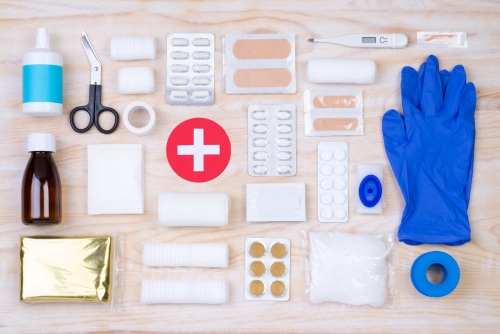
Workplace-Specific Supplies
The contents of a workplace first aid kit should comply with workplace early medical aid kit & supplies regulations established by organizations like OSHA (Occupational Safety and Health Administration) in the United States. These regulations specify the required contents and number of kits based on the size, industry, and potential hazards of the workplace. The table below provides examples of workplace emergency kit recommendations for various industries:
| Industry | Recommended Supplies |
| Construction | Eye wash solution, safety glasses |
| Manufacturing | Chemical-resistant gloves, burn cream |
| Office | Antihistamines, insect sting relief wipes |
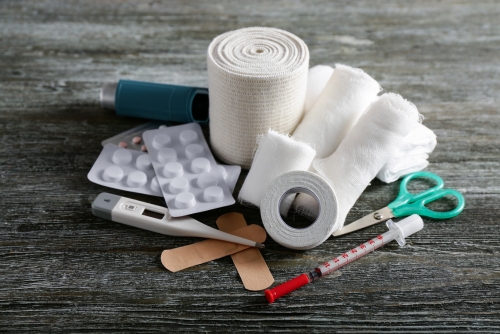
Home Kit Additions
In addition to the common supplies, consider adding items specific to your household's needs. This might include pain relievers for adults and children, allergy medications, or a medication dispenser for those with chronic conditions.
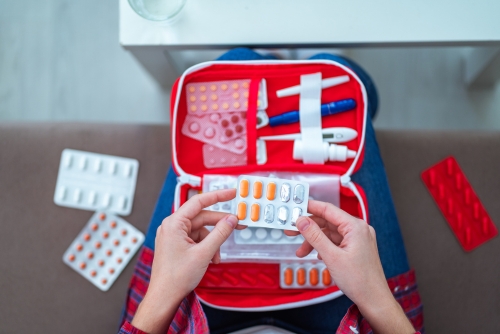
Travel Kit Considerations
For travel emergency kits, think about including insect repellent, sunscreen, motion sickness medication, and any other supplies relevant to your destination.
Optional Extras
While not essential, some additional items can enhance your kit's functionality:
- Emergency blanket: Helps retain body heat in case of hypothermia.
- CPR mask: Provides a barrier during CPR administration.
- AED (automated external defibrillator): Can be lifesaving in case of cardiac arrest (availability may vary depending on regulations).
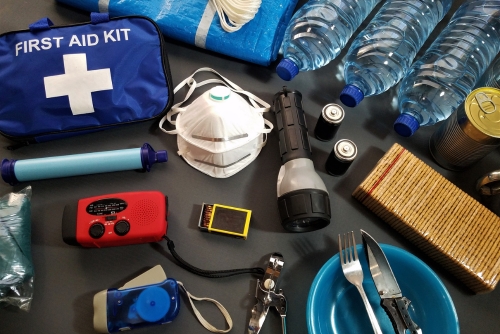
OSHA Regulations for Workplace First Aid Kits
The Occupational Safety and Health Administration (OSHA) plays a vital role in ensuring workplace safety in the United States. OSHA has established specific standards regarding workplace first aid kits. These standards outline the required contents and the number of kits necessary for a workplace, depending on the size and potential hazards.
Here's a breakdown of key points to remember:
- Minimum Contents: OSHA mandates that all workplace emergency kits contain a minimum set of supplies, including sterile dressings, bandages, antiseptic wipes, and eye wash solution (for workplaces with potential eye hazards).
- Industry-Specific Requirements: Beyond the minimum contents, workplace first aid kits may need additional supplies based on the specific industry and potential hazards. For instance, construction sites might require eye wash solution for chemical splashes, while laboratories might need chemical-resistant gloves.
- Number of Kits: The number of kits required in a workplace depends on the number of employees and the size of the facility. OSHA provides resources and guidelines to help employers determine the appropriate number of kits for their workplace.
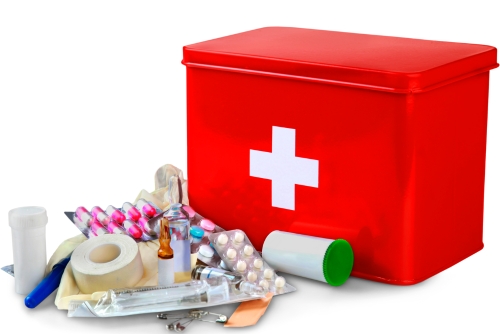
It's important to note that OSHA standards are not the only regulations governing workplace emergency kits. Other safety organizations like the American National Standards Institute (ANSI) may have additional recommendations. Additionally, regional and provincial regulations (particularly in Canada) may also apply. Employers should consult with relevant authorities to ensure compliance with all applicable regulations.
Maintaining and Refilling Your First Aid Kit
Having a well-stocked personal emergency kit is only half the battle. Regular maintenance is crucial to ensure its effectiveness. Here's why checking and refilling your first aid kit is important:
- Expired Supplies: Many early medical aid supplies, like antiseptic wipes and medications, have expiry dates. Using expired supplies can be ineffective or even harmful.
- Depleted Quantities: Through use, some supplies may run low. Regularly checking your kit ensures you have enough items on hand to handle potential injuries.
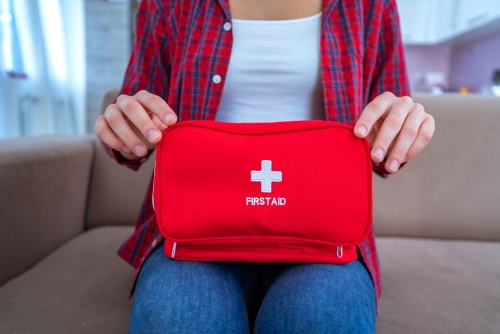
Creating a Refilling Schedule
The frequency of checking and refilling your emergency kit depends on usage and expiry dates. Here's a suggestion for a refilling schedule:
- High-Use Kits: For frequently used kits, such as those in workplaces or for families with active children, a monthly check and refill might be necessary.
- Home Kits: For home kits, a quarterly check is generally sufficient.
Refilling vs. Replacing Your Kit
Don't feel obligated to replace your entire first aid kit every time supplies run low. In most cases, it's more cost-effective and environmentally friendly to simply refill the expired or used items.
First Aid Kit Checklist
A first aid kit checklist can be a valuable tool for maintaining your kit. This checklist should include a list of all the supplies in your kit, along with their expiry dates and recommended quantities. Some resources even offer downloadable or printable medical emergency kit checklists.
Proper Storage Methods
For optimal functionality, store your emergency kit in a cool, dry, and easily accessible location. Avoid storing it in direct sunlight or extreme temperatures, as this can affect the potency of certain supplies.
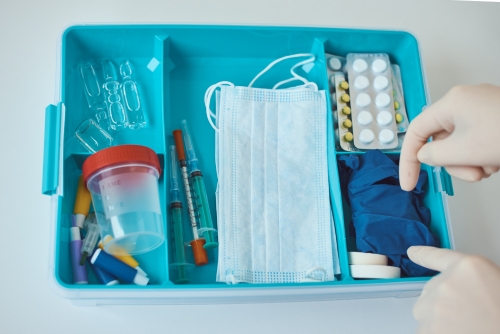
How can I use my first aid kit effectively in an emergency?
Upgrade your first-aid kit from a box to a lifeline. This guide equips you to tackle everyday injuries with confidence. No more fumbling – learn essential techniques to get the most out of your supplies, transforming minor mishaps into manageable moments.
Basic First Aid Principles
Before diving into specific injuries, let's review some fundamental first-aid principles:
- Scene Assessment: Always ensure your safety and the safety of others before providing first aid. Assess the scene for any potential hazards that could worsen the injury.
- Prioritize Safety: If the situation is life-threatening (e.g., severe bleeding, unconsciousness), call emergency services immediately.
- Stopping Bleeding: For minor bleeding, apply direct pressure with a clean cloth or bandage. If the bleeding persists, seek medical attention.
Remember, a first aid box is intended for minor injuries. For serious injuries, it's crucial to seek professional medical attention.
Common Misconceptions About First Aid Kits
There are several myths surrounding first aid kits. Here are two common ones debunked:
- Myth 1: First Aid Kits Replace Medical Care: Emergency kits are for providing basic medical emergency kits and should not be seen as a substitute for professional medical care. For serious injuries or persistent issues, always consult a doctor.
- Myth 2: First Aid Kits Last Forever: As mentioned earlier, many first aid supplies have expiry dates. Regularly checking and refilling your pack ensures you have effective supplies on hand.
Step-by-Step Instructions for Treating Common Injuries
Now, let's delve into how to use your emergency kit for some of the most common injuries:
A. Cuts and scrapes
- Gently clean the wound with clean water or antiseptic wipes.
- Apply pressure with a sterile gauze pad to stop any bleeding.
- Cover the wound with an adhesive bandage or dressing.
- Monitor the wound for signs of infection (redness, swelling, pus).
B. Burns
- Cool the burn immediately by running cool water over it for 10-15 minutes (avoid using ice).
- Do not apply butter, ointments, or lotions to the burn.
- Cover the burn loosely with a sterile dressing.
- For severe burns, seek medical attention immediately.
C. Sprains and Strains
- Apply the RICE principle: Rest, Ice, Compression, and Elevation.
- Rest in the injured area and avoid activities that worsen the pain.
- Apply ice wrapped in a cloth to the injured area for 15-20 minutes at a time, several times a day.
- Compress the area with a bandage to reduce swelling.
- Elevate the injured limb above the heart to reduce swelling.
Basic First Aid Techniques for Common Injuries
This section expands on the previous one by providing more detailed first-aid techniques for common injuries:
- Wound Cleaning: There are different types of wounds, each requiring a specific cleaning method. For instance, puncture wounds might require irrigation with a sterile saline solution, while abrasions benefit from gentle cleaning with water.
- Recognizing Infection: Signs of infection include redness, swelling, pain, and pus drainage from the wound. If you notice any of these signs, seek medical attention promptly.
- Applying Bandages and Dressings: Proper application of bandages and dressings is crucial for optimal healing and preventing infection. Techniques vary depending on the type and location of the injury. Consider consulting an emergency box manual or instructional videos for detailed guidance.
- Basic Techniques for Sprains and Strains: RICE is a great starting point, but additional techniques like using crutches or splints might be necessary depending on the severity of the sprain or strain. Consulting a doctor can ensure proper diagnosis and treatment.
Remember, these are just general guidelines. Always refer to a personal emergency pack manual or consult a healthcare professional if you're unsure how to handle a specific injury.
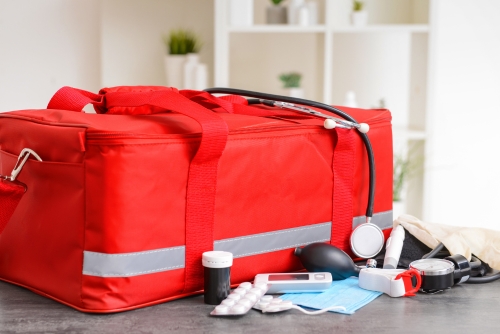
Conclusion
Having a well-stocked and readily available emergency kit is an essential part of being prepared for emergencies, both at home and in the workplace. This comprehensive guide has equipped you with the knowledge to choose the right medical emergency box for your needs, maintain it effectively, and use it confidently for common injuries.
Remember, preparedness is key. ** Take action today by assembling or replenishing your medical emergency Pack. Feel free to customize your pack based on your specific needs and activities. There are also many online resources and first aid courses available to deepen your knowledge and skills.
Frequently Asked Questions to address common concerns about first aid kits
What are 10 items in a first aid kit?
A well-stocked first aid kit typically includes:
- Adhesive bandages in various sizes
- Antiseptic wipes or solution
- Gauze pads in different sizes
- Roller bandage
- Triangular bandage
- Medical tape
- Scissors and tweezers
- Instant cold compress
- Pain relievers (for adults and children, if appropriate)
- Thermometer (optional)
This is a general list, and the contents of your first aid kit may vary depending on your specific needs and environment.
What is the golden rule of "Not harm" in first aid?
The golden rule of a medical emergency pack is "Not harm." This means prioritizing the safety of yourself and the injured person. Assess the scene for hazards and avoid actions that could worsen the injury. If you're unsure how to handle a situation, it's always best to seek professional medical attention.
Where can I buy a first aid kit?
Medical emergency kits can be purchased from a variety of retailers, including pharmacies, grocery stores, and online stores.
How often should I check my medical emergency pack?
The recommended frequency depends on usage and expiry dates. Monthly checks are ideal for high-use packs, while quarterly checks are sufficient for most home packs.
What if I'm unsure how to use a specific item in my medical emergency pack?
There are several resources available to help you understand how to use first aid supplies effectively. Here are a few suggestions:
- First Aid Manual: Many first aid kits come with a basic manual that outlines instructions for using common supplies.
- Online Resources: Reputable websites like the American Red Cross offer free resources and instructional videos on first aid techniques.
- First Aid Courses: Consider enrolling in a medical emergency pack course offered by organizations like the American Red Cross or your local community center. These courses provide hands-on training and can significantly boost your confidence in managing emergencies.
What is the difference between a first aid kit and a first aid box?
A medical emergency pack is a vital component of an emergency kit, but it's not the only element. An emergency kit may also include:
- Flashlight and extra batteries
- Emergency blanket
- Bottled water and non-perishable food
- Basic tools and a whistle
- Personal medications (if applicable)
- Copies of important documents
The contents of your emergency pack will depend on your specific needs and potential emergencies in your area.
What should I do if someone is bleeding heavily?
Apply direct pressure to the wound with a clean cloth or bandage. If the bleeding persists after applying pressure for several minutes, call emergency services immediately.
Can a first aid kit treat all injuries?
No, emergency kits are intended for minor injuries. For serious injuries or persistent issues, seek medical attention from a doctor or emergency services.
Do first aid kits expire?
Yes, many medical emergency pack supplies have expiry dates. Regularly checking and refilling your pack ensures you have effective supplies on hand.
Why is a first aid kit typically colored red?
Red is a universally recognized color associated with danger, warnings, and stopping. A red medical emergency pack is easily identifiable in an emergency, allowing for quick access to medical supplies.
Why is a first aid kit important?
A first aid kit is important because it allows you to provide immediate care for minor injuries, which can help prevent them from worsening and promote faster healing. It can also be lifesaving in certain situations by providing basic supplies for controlling bleeding or treating allergic reactions until medical help arrives.
First aid kit for cars?
In addition to a general first aid kit, consider assembling a car medical emergency pack specifically for emergencies on the road. This kit might include additional items like jumper cables, flares, a road atlas or GPS system, and a reflective vest.
By following the tips and information provided in this guide, you can ensure that you and your loved ones are prepared to handle minor injuries with confidence. Remember, a little preparation can go a long way in promoting a safe and healthy environment.

